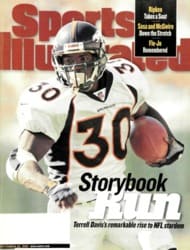
Florence Griffith Joyner (1959-98)
Close your eyes and speak her stage name: Flo-Jo. An image forms
in the mind. She's running impossibly fast, drawing clear from
others in the race while wearing a uniform that's the child of
Nike and Victoria's Secret. Her long nails rake the air in
abrupt, efficient strokes, and her raven hair trails behind her.
At the finish, an expressionless face suddenly beams. It's a
picture of speed and beauty and joy, and, once witnessed, it's
unforgettable.
Florence Griffith Joyner was not alone among athletes in burning
herself into the public memory. Jordan, Tiger, Big Mac. The list
grows. But Flo-Jo was alone in her sport. When she died in her
sleep early Monday morning of an apparent heart seizure at age
38, she left a legacy not just of decade-old world records but
also of a personal and athletic style that mixed with a savvy
business acumen to propel her far beyond the arena in which she
competed. Track and field is fighting for survival precisely for
the lack of electric stars like Flo-Jo, who even at the time of
her death, 10 years past her prime, remained in possession of
her milk mustache.
In the summer of 1988 Griffith Joyner (who was married to triple
jumper Al Joyner and was the sister-in-law of Jackie
Joyner-Kersee) exploded from the workaday sprinter who had won
the silver medal in the 200 meters at the boycott-thinned 1984
Olympics into the fastest woman in history. She ran the 100 in
10.49 seconds in a heat at that year's U.S. Olympic Trials, a
world record that wasn't approached until this month, when
Marion Jones ran 10.65. Flo-Jo won three gold medals at the '88
Games and set a world record of 21.34 in the 200. Jones, the
second-fastest woman ever, ran 21.62 this year, still far off
the mark. "She was just on another level," says '84 Olympic 100
champion Evelyn Ashford, who was second to Flo-Jo in '88.
It wasn't simply the speed with which Flo-Jo rose to greatness
that formed her legend but also the style. She wore one-legged
unitards and lace attachments when other women were still
wearing shorts. She wore makeup and grew spectacularly long
nails. She melded athleticism and glamour like no other woman.
Sprint coach and former U.S. Olympian John Smith saw Flo-Jo run
in the spring of 1988 and was stunned by her progress and her
appearance. "Florence--we all called her Florence then--was
always a hard worker and she had good form," says Smith, "but
that year she had the outfits and the nails and the name, and
she was in the best shape of her life. Suddenly, she just had
everything figured out. It was beautiful to watch."
In retirement Griffith Joyner served as a co-chair of the
President's Council on Physical Fitness and Sports and designed
uniforms for the Indiana Pacers. She vowed to one day run a
marathon. Whatever she did, wherever she went, she remained more
recognizable than any active track and field athlete.
Flo-Jo also was followed to her death by unsubstantiated
accusations that performance-enhancing drugs were responsible
for her fast times. Those rumors won't fade with her passing,
because heart disease is a known side effect of anabolic steroid
use. But the link between sports and chemistry has grown
stronger in the years since Flo-Jo ran; now home run kings
legally gobble natural enhancers and college football players
sprinkle Creatine on their cereal.
Florence Griffith Joyner died young, leaving a seven-year-old
daughter and a husband whose own mother died at 37. She ran fast
and beautifully, and it's best now to remember only that, to let
the whispers fall silent.
--Tim Layden
COLOR PHOTO: PHOTOGRAPH BY MANNY MILLAN [Florence Griffith Joyner running in race]

